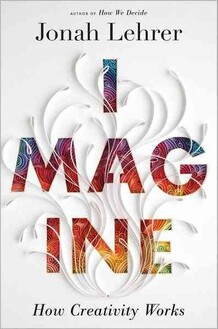Lehrer defines creativity broadly, considering everything from the invention of masking tape to breakthroughs in mathematics; from memorable ad campaigns to Shakespearean tragedies. He finds that the conditions that favor creativity — our brains, our times, our buildings, our cities — are equally broad.
Lehrer joins NPR's Robert Siegel to talk about the creative process — where great ideas come from, how to foster them, and what to do when you inevitably get stuck.
How Creativity Works
Interview Highlights
Hardcover, 256 pages |Purchase Featured Books
On comparing Shakespeare with the inventor of masking tape
"I think we absolutely can lump them all together. I think one of the mistakes we've made in talking about creativity is we've assumed it's a single verb — that when people are creative they're just doing one particular kind of thinking. But looking at creativity from the perspective of the brain, we can see that creativity is actually a bundle of distinct mental processes.
"... Whether you're writing a Shakespearean tragedy, or trying to come up with a new graphic design or writing a piece of software, how we think about the problem should depend on the problem itself. Creativity is really a catch-all term for a variety of very different kinds of thinking."
On how Steve Jobs redesigned Pixar studios to maximize collaboration and creativity
"The original design for the Pixar studios consisted of three separate buildings, where they'd put the computer scientists in one building, and the animators in a second building and the third building would contain everybody else: the directors, the editors and so on. Steve realized that that was a terrible idea; that the real challenge of Pixar was getting people from these different cultures — these computer scientists and these cartoonists — to work together, to really collaborate. And so he insisted that Pixar studios just be one vast, cavernous space."
On forcing people to meet and mingle ... even if it's in the bathroom
"[Jobs] insisted there be only two bathrooms in the entire Pixar studios, and that these would be in the central space. And of course this is very inconvenient. No one wants to have to walk 15 minutes to go to the bathroom. And yet Steve insisted that this is the one place everyone has to go every day. And now you can talk to people at Pixar and they all have their 'bathroom story.' They all talk about the great conversation they had while washing their hands.
" ... He wanted there to be mixing. He knew that the human friction makes the sparks, and that when you're talking about a creative endeavor that requires people from different cultures to come together, you have to force them to mix; that our natural tendency is to stay isolated, to talk to people who are just like us, who speak our private languages, who understand our problems. But that's a big mistake. And so his design was to force people to come together even if it was just going to be in the bathroom."

Nina Subin/Courtesy Houghton Mifflin Harcourt
Jonah Lehrer is a contributing editor at Wired magazine and the author of How We Decide and Proust Was a Neuroscientist.
On the relationship between creativity and originality — and being triggered by other people's ideas
"The brain is just an endless knot of connections. And a creative thought is simply ... a network that's connecting itself in a new way. Sometimes it's triggered by a misreading of an old novel. Sometimes it's triggered by a random thought walking down the street, or bumping into someone in the bathroom of the studio. There are all sorts of ways seemingly old ideas can get reassembled in a new way."
On the creative processes that resulted in Nike's "Just Do It" campaign
"This is a great story from Dan Wieden at Wieden+Kennedy, the very honored Portland ad firm. ... He'd come up with seven videos for the new Nike ad campaign. ... He knew these different videos which featured different sports needed a shared slogan. But he just couldn't think of the slogan. ... At some point during the day, somebody must've mentioned Norman Mailer to him. And so Norman Mailer was in the back of his head somewhere.
"It's near midnight. His deadline's approaching. He's really, really frustrated at this point because he can't come up with this damn slogan. And then suddenly he thinks of Norman Mailer. He remembers Norman Mailer wrote this book called The Executioner's Song about Gary Gilmore. And he remembers Gary Gilmore's last words right before he's executed by a firing squad in Utah. His last words were, 'Let's do it.'
"And Dan Wieden thinks to himself, Geez, that's pretty brave. That's a pretty brave sentiment to have right before you die — to just get it over with. But he realizes 'Let's Do It' isn't quite right, so he tweaks one word. And there you get 'Just Do It.' ... But that's a perfect example of how, in a sense, that's an old idea. It was a line in a Norman Mailer book, and he tweaked it ever so slightly. He substituted one word and came up with one of the most influential advertising slogans of the second half of the 20th century."
"The question becomes, what happens if you hit the wall? Because we've all got experience with this. You're working on a creative problem, and then all of a sudden that feeling of progress disappears ...
Buy the book - read more: NPR.com








No comments:
Post a Comment